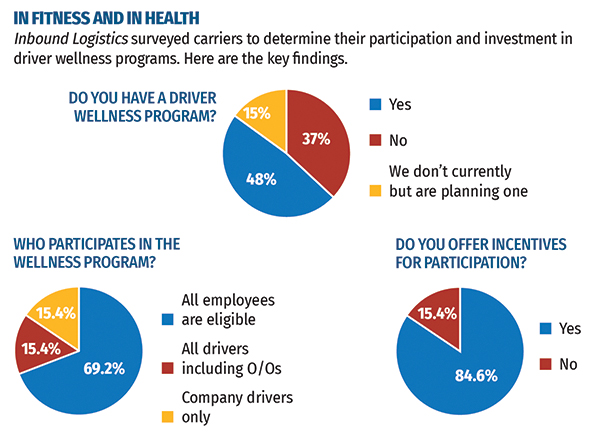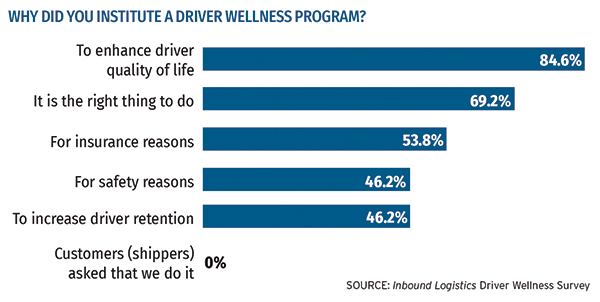Driver Wellness Programs: The Right Thing to Do

Wellness programs keep drivers healthy, and carriers wealthy and wise.
Driver wellness has become a key issue in the trucking industry. Legislators have attempted to address some driver health and safety issues by implementing strict Hours-of-Service (HoS) regulations that keep drivers from staying on the road too long. HoS compliance is carefully tracked using required on-board electronic logging devices that make it nearly impossible for drivers to put in extra time behind the wheel.
Driver Wellness: Why Should Shippers Care?
Drivers are at high risk for a range of health problems—heart disease, obesity, sleep apnea, and stress—that can result from a sedentary job. On the flip side, carriers need drivers to stay healthy and work longer to provide much-needed capacity. Drivers themselves have near-limitless employment alternatives if their current carrier doesn’t treat them right. All these factors drive many carriers to protect the health of their valued workers.
The ROI of Driver Wellness
More than 70 percent of freight that moves within the United States annually does so on the highway, according to the American Trucking Associations (ATA). The ATA estimates 3.5 million truck drivers are needed to maintain this level of service, yet the industry faces a shortage of more than 50,000 drivers. This number is expected to continue increasing as baby boomers, who make up a majority of current truck drivers, reach retirement age.
Drivers retire and can’t be replaced. Now consider rising health problems among truckers, who alternate long periods of sitting with intense physical labor. While many sectors can count on workers to extend careers into their 70s and beyond, a driver’s late-stage career is less predictable.
Driver wellness programs help to offset many risks associated with a long-term truck driving career, and have proven a valuable tool in the battle against the driver shortage. These programs encourage healthy behavior that keeps drivers fit and on the highway much longer than they might otherwise be capable of. Yet, only 48 percent of carriers have a driver wellness program in place, according to a recent survey of carriers conducted by Inbound Logistics. While 15 percent say they plan to start a wellness program in 2018, that still leaves 37 percent of carriers that have no program and no intentions to start one.
“Return on investment (ROI) in wellness programs can be seen in reduced healthcare and workers’ compensation costs, a decrease in absenteeism, and higher recruitment and retention rates,” says Melissa Morrett, an independent wellness consultant and former manager of employee benefits and wellness programs for a U.S. carrier.
“When you consider that the average cost to identify, recruit, and train a driver can exceed $6,800, it is alarming to see that the driver turnover rate for large truckload carriers stays near 100 percent,” she adds. “Turnover challenges, coupled with rising healthcare costs, mean the trucking industry faces a huge financial burden. So, any ROI is crucial to a carrier’s success.”
Of course, return on investment isn’t always about the bottom line and what can be strictly measured. Results often come in the form of happier drivers who feel good, and many companies are content to simply provide a healthier work environment for drivers.
“The role that a successful wellness program plays in so many different components of a company’s success makes it hard to place an exact numerical value on the benefits,” says Ali John, manager of corporate wellness for global transportation provider Werner Enterprises. “The bottom line is that healthier drivers go to the doctor less, are behind the wheel more, and have more productive working hours.
“We can quantify that each driver who takes 1,000 more steps, smokes 10 fewer cigarettes, or eats 100 fewer calories per day as a part of a wellness plan is making great strides in the right direction,” she adds. “Drivers who become more aware of their personal health and take small steps toward living a healthier lifestyle, will improve their fitness, morale, productivity, and attitude.
“The best part is they will likely share this change and feeling with co-workers, which creates a ripple effect,” John says. “Werner’s driver wellness program helps create awareness and plant seeds for healthy behavior.”
The Right Reasons
ROI aside, most of the carrier respondents to IL’s survey implemented their program simply because they felt it was important. Among carriers with an existing driver wellness program, 69 percent say they began it because it was the right thing to do, while nearly 85 percent say they want to enhance the quality of life their drivers experience (see chart, right).
“Truck drivers are the backbone of the American economy, and while ROI is important, it is also important to show appreciation for the sacrifices drivers make every day to ensure the economy keeps rolling,” Morrett says. “Wellness programs and health education—if implemented industry wide—have the potential to alter society’s perception of truck drivers.
“A renewed perception might improve the likelihood that the younger generation will step up to fill the seats of those retiring,” she adds. “Wellness programs are an essential component in the solution to the driver shortage.”
The elements of each carrier’s wellness program vary, but they all share the same goal: healthier drivers. When designing a wellness program, it’s crucial that carriers talk to their drivers about their concerns and find out what types of wellness services they feel they will benefit from. At Werner, for example, the company’s Wheels for Wellness began with a focus on the most common health issues that impact drivers.
In the Driver’s Seat
“Drivers should have a seat at the table during the planning phase of implementing a wellness program,” says Morrett. “Typically, the person putting together a program has never been behind the wheel. Incorporating driver input into the wellness program excites and motivates drivers to participate.”
Asking drivers to identify health challenges offers valuable insight when developing new programs. Tackling key health issues should be any program’s prime area of focus.
“The health areas of greatest focus mirror many risk factors for heart disease: weight management, diabetes, high blood pressure and cholesterol, physical activity, and tobacco use,” John says.
Like Werner, the rest of the industry has similar concerns, which offers developers of new programs a resource when building their own wellness initiatives. There may be no one-size-fits all solution to driver wellness, but these types of broad problems in the sector offer a valuable starting point for any carrier.
“Besides health problems, drivers are faced with being away from family for extended periods of time, financial stressors, and feeling disrespected by colleagues and customers,” Morrett says. “With a commitment to health coaching and monitoring, drivers can get many of these issues under control, and limit the impact they have on performance.
“From a safety standpoint, it is essential to avoid any potential accident a health condition can cause,” she adds.
In the interests of doing the right thing, remember that wellness programs don’t have to belong only to employees who drive trucks. Among those trucking companies surveyed by IL, 69 percent offer a wellness program to all employees, and 15 percent extend wellness initiatives to owner-operators.
Encouraging Participation
In spite of the obvious benefits, healthy living can be a hassle on the road and some drivers may not want to participate. While all the carriers IL surveyed say their wellness program is optional, nearly 85 percent offer some sort of incentive—from financial bonuses to additional paid days off—to encourage participation.
“Participation rates continue to increase as word spreads about the program and we make it is as accessible to drivers as possible,” John says of Werner’s program. “Drivers who participate and are covered under Werner’s health insurance plan receive an annual premium reduction for the next calendar year.”
Among the driver wellness programs that IL surveyed, participation varies. Fifteen percent of respondents say they have 75 percent participation, while 15 percent cite 50 percent participation, and 46 percent have at least 25 percent of drivers actively involved. The remaining percentage doesn’t track participation.
Morrett’s former carrier used health insurance premium discounts and other incentives to encourage drivers to engage with the wellness program. “Drivers appreciated the incentive because it showed that the company genuinely cared about their health, while putting money back in their pockets,” she says. “At the same time, this initiative resulted in healthier drivers and lower healthcare costs for the company.”
Investing in Drivers
Driving is a difficult job. Drivers spend significant time away from family and friends. They eat on the go and sit behind the wheel for hours. Sleep schedules change from one day to the next, making it difficult to get quality rest. Finding time for exercise can be challenging, and making time for regular medical check-ups can be worse.
It’s up to carriers to provide options that enable drivers to invest in their own health and wellness, and it’s the responsibility of shippers to support and supplement those initiatives.
It’s the right thing to do.
Driver Wellness: Why Should Shippers Care?
Driver wellness can extend beyond carriers to customers. Shippers who don’t manage or employ drivers directly may wonder why driver wellness should concern them. But driver health and happiness benefits shippers in the following direct ways:
Capacity. Happy and healthy drivers come to work, which helps carriers maintain capacity levels. Considering the lack of available capacity in the United States, this makes driver wellness crucial for the entire supply chain.
Rates. Unhealthy drivers need extra medical care, more sick days, and other requirements, all of which can drive up costs for the carrier. When carriers experience increased financial burden, they pass those costs on to shippers through rate increases.
Retirement. Drivers who don’t feel well or suffer from chronic health issues will likely retire as soon as they are able. This has seriously impacted the entire freight sector in recent years as baby boomers retire without replacements.
Recruitment. Drivers have frequent contact with the general public. Healthy drivers will project a more positive brand image for the trucking sector and the supply chain as a whole, which will be crucial to recruiting younger drivers.
Safety. Drivers who take a vested interest in their own health will be more alert on the road, which increases the odds that shipments arrive safely and undamaged.
Shippers can get on board with wellness easily enough by making their facilities friendly to drivers. Offering a driver-friendly destination can turn a shipper into a carrier favorite, which means the carrier will prioritize that shipper for available capacity when things get tight.
A number of features make a location driver-friendly, including drop-and-hook yards, Wi-Fi availability, sleeping areas, food, exercise equipment, bathrooms, showers, driver lounges, and more.
If you show appreciation for the drivers who move your cargo, rest assured that they will show it in return.


